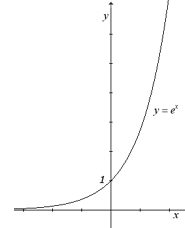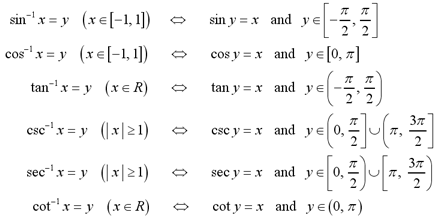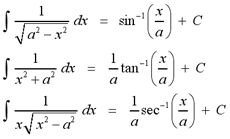|
Before continuing with the inverse functions
tutorial, it's recommended that you review the exponents, logarithms
and trigonometry tutorials at the links below.
Exponents
Tutorial
Logarithms
Tutorial
Trigonometry
Tutorial
To fully understand the concept of an inverse
function, we must first review the concept of a one-to-one function in the
glossary.
Suppose f is a one-to-one function with domain X
and range Y. The inverse function f -1 has domain Y and
range X and is defined by

for any y in Y.
The images below illustrate the concept of an
inverse function.
Note: The notation for
an inverse function, f -1 is often mistaken with an
exponenetial expression. To express the reciprocal 1/f(x), we would
write [f(x)]-1.
Cancellation Equations
The composition of inverse functions yields some
very interesting results. The following equations are known as cancellation
equations for inverse functions.

Steps for Finding Inverse Functions
If we are given the formula for a function f(x),
how do we find the formula for the inverse function f -1?
The steps below describe the process to determine the inverse of a
function.
1) Write the formula for the function, y=f(x).
2) If possible, solve the equation for x in terms
of y.
3) Interchange the variables x and y, so that the
inverse is a function of x. We end up with the function, y = f -1(x).
Inverse Functions and Calculus
There are two theorems that relate the inverse
functions to concepts covered in previous calculus tutorials. The first
theorem deals with the continuity of inverse functions.
If f is a one-to-one function and is continuous
on an interval I, then it inverse function, f -1 is
continuous on f(I).
Note: This is due to
the fact that the domain of the inverse function f -1 is the
range of f, as explained above.
The next theorem gives us a formula to calculate
the derivative of an inverse function.
If f is a one-to-one, differentiable function
with inverse, g=f -1 and f'(g(a)) does not equal 0, then the
inverse function is differentiable at a and

Examples
1
| Find a formula for the inverse function
2
| Find the derivative of the inverse function at a
Recall the irrational number e from the logarithm
tutorial. When we first introduced this number, we did not have the
knowledge of calculus to properly define it.
The irrational number e is a number such that

From the definition of e, it can be shown that

Graph of the Natural Exponential Function

The function f(x) = ex is known as the
natural exponential function. The graph to
the right shows the natural exponential function. We can see that the
function is increasing and continuous for all values of x in R. The
domain is X = {x | x is in R) and the range is Y = {y | y > 0}.
The graph also illustrates the functions
behaviour as x approaches positive and negative infinity.

The natural exponential function has a horizontal
asymptote at y = 0.
The Derivative and Integral of the Natural
Exponential Function
The natural exponential function has a very
simple derivative.

If we combine the formula above with the chain
rule, the formula becomes

Since the derivative of the exponential function
is so simple, it is very easy to calculate the integral.

Examples
3
| Find the derivative of the function
4
| Find the derivative of the function by implicit differentiation
5
| Find the integral of the function
We can apply the concepts of calculus to
logarithmic functions, so that we can better understand them. In order
to graph logarithmic functions, we will need to know how they behave at
infinity and at the vertical asymptote x = 0. If a > 1, then

Similarly, the following limits indicate the
behaviour of the natural logarithmic function as x approaches infinity
and as x approaches 0.

Note: Recall that
logarithmic functions and the natural logaritmic function are not
defined for x less than or equal to 0.
Recall the natural logarithmic function, y = ln
x. Since The derivative of the natural logarithmic function is given by
the formula below.

If we combine the formula above with the chain
rule, the formula becomes

The integral that corresponds with the derivative
of the natural logarithmic function, shown above, is given by the
formula below.

From the derivative of the natural logarithmic
function, we get the formula for the derivative of regular logarithimic
functions.

From the derivatives of the natural exponential
and natural logarithmic functions, we have a formula for the derivative
of exponential functions with base a. These functions have the form ax

The integral of an exponential function with base
a is given by the following formula

Note: Be careful not to
confuse the exponential function ax with the function xa.
The function, ax has a variable exponent and constant base.
When differentiating, we use the formula above. The function xa
has a constant exponent and variable base. When differentiating, we
simply use the power rule.
The formulas above are very important to
remember. Since there are so many and they are so similar, students
often get confused between the different formulas. In your textbook,
there are full derivations of each formula. Many of these derivations
are simple enough that students can simply derive the formula on a test
or exam. It may be helpful to look over these derivations if you find
it difficult to memorize the formulas.
Examples
6
| Find the derivative of the function
7
| Find the integral of the function
8
| Find the derivative of the function
9
| Find the derivative of the function
10
| Find the integral of the function
The process of logarithmic differentiation
allows us to calculate the derivatives of complicated functions. For
example, the function y = xx cannot be differentiated using
any of the methods we have covered thus far. The steps of logarithmic
differentiation are outlined below.
1) Given an equation y = f(x), take the logarithm
of each side and simplify the equation using the properties of
logarithms.
2) Use the method of implicit differentiation to
differentiate the simplified equation, with respect to x.
3) Solve the equation for y'
Although this method of differentiation may seem
complicated, it will be much clearer after a few examples.
Examples
11
| Solve the function using logarithmic differentiation
12
| Solve the function using logarithmic differentiation
This section combines the idea of inverse
functions with trigonometric functions. However, for a function to have
an inverse function, it must be one-to-one. Although trigonometric
functions are not one-to-one, (try applying the horizontal line test to
y = sin x, for example), we can restrict the domain so that they become
one-to-one functions.
Recall the graph of the sine function from
the trigonometry tutorial. If we restrict the domain of the function to
-pi/2 < x < pi/2, the function becomes one-to-one. The inverse of
this function exists and is called the inverse sine function,
denoted sin-1 or the arcsine function, denoted
arcsin. These two notations are used interchangeably.
The definition of the inverse sine function is
shown below.

The graphs of the sine function and the
corresponding inverse sine function are shown below.
Since the arcsine and sine functions are inverse
functions, we can apply the cancellation equations. The cancellation
equations are shown below.

Note: When using any of
the trigonometric cancellation equations, we must be sure that x lies
in the specified interval. If it does not, we cannot apply the
cancellation equation and must find some alternate approach to solve
the problem.
We can also relate the concept of an inverse
trigonometric function with calculus. The inverse sine function, sin-1
with domain [-1, 1] and range [-pi/2, pi/2] is continuous. The
derivative of the inverse sine function is given by the formula below.

From the differentiation formula, we also have a
formula for integration that involves the inverse sine function.

The inverse cosine function is defined
quite similarly to the inverse sine function. The domain of the cosine
function is restricted to [0, pi], so that the it becomes a one-to-one
function. The definition of the arccosine function is shown below.

The graphs of the cosine function and the
corresponding inverse cosine function are shown below.
The canellation equations become

The inverse cosine function, cos-1
with domain [-1, 1] and range [0, pi] is continuous. The derivative of
the inverse cosine function is given by the formula below.

From the differentiation formula, we also have a
formula for integration that involves the inverse cosine function.

Note: The integral
above could also be evaluated to -sin-1 x + C. By
convetnion, we calculate all variations of the integral above to be
equal to the inverse sine function. The inverse cosine function is
still correct, but it is preferred that you express the integral as the
inverse sine function.
The inverse tangent function is also
similar to the previously defined inverse trigonometric functions. The
domain of the tangent function is restricted to [-pi/2, pi/2], so that
it becomes a one-to-one function. The definition of the arctangent
function is shown below.

The graphs of the tangent function and the
corresponding inverse tangent function are shown below.
The canellation equations become

The inverse tangent function, tan-1
with domain, R and range (-pi/2, pi/2) is continuous. The derivative of
the inverse tangent function is given by the formula below.

From the differentiation formula, we also have a
formula for integration that involves the inverse tangent function.

Although the remaining trigonometric functions
exist, they are not used as frequently as the three defined above. The
table below summarizes the definitions of all inverse trigonometric
functions.

The following table summarizes the
differentiation formulas for all inverse trigonometric functions.

In addition to the integration formulas above,
there are a few other useful integration formulas that involve the
inverse trigonometric functions.

Examples
13
| Evaluate the inverse trigonometric functions
14
| Find the derivative of the function
15
| Find the derivative of the function
16
| Find the integral of the function
17
| Find the integral of the function
For more practice with the concepts covered in
this tutorial, visit the Inverse Functions Problems page
at the link below.
The solutions to the problems will be posted after these chapters are
covered in your calculus course.
To test your knowledge of inverse function problems, try taking the
general inverse functions test on the iLrn website or the
advanced
inverse functions test at the link below.
Inverse Functions
Problems
General Inverse Functions Test on iLrn
Advanced Inverse Functions
Test
|Top
of Page |
|

